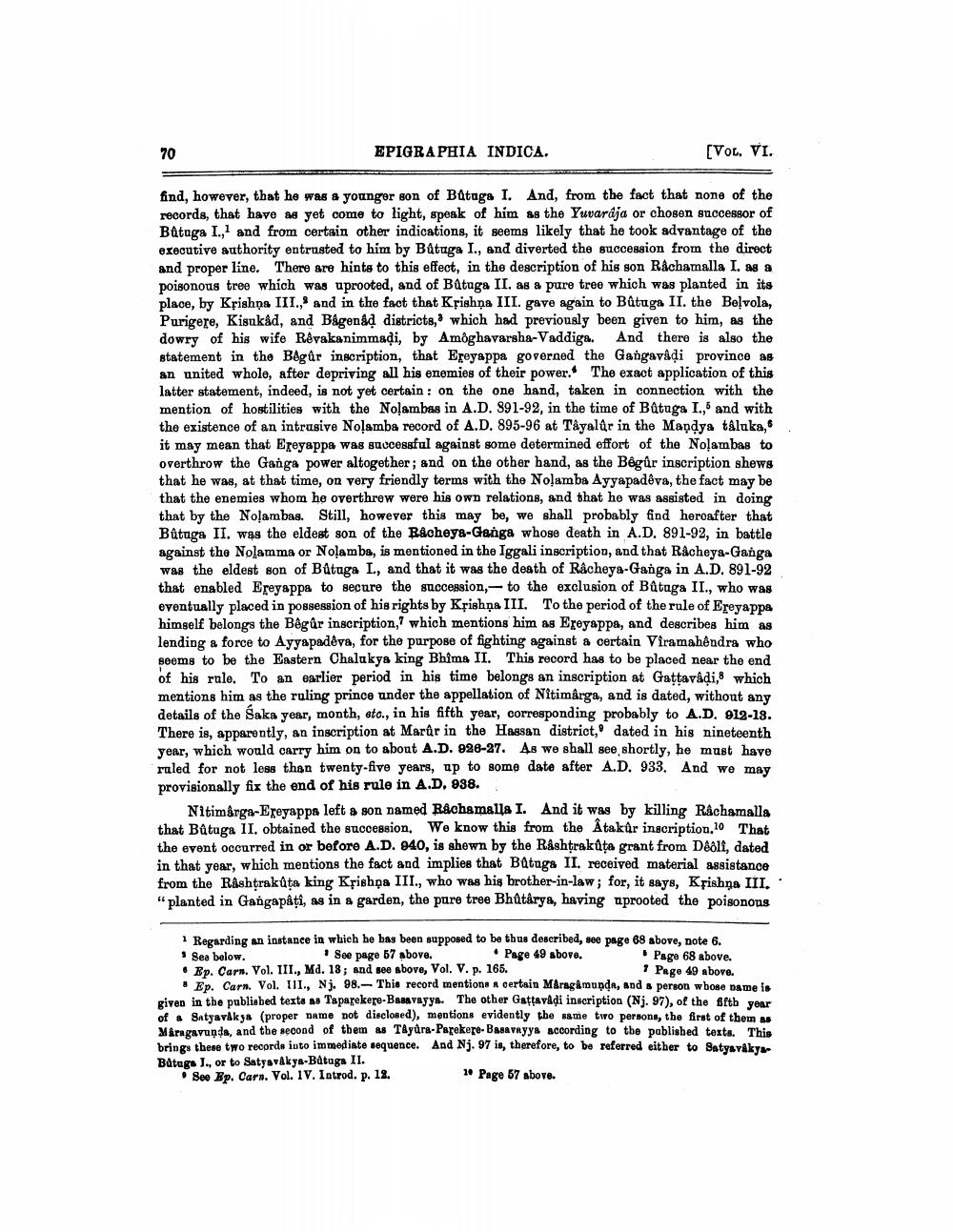________________
70
EPIGRAPHIA INDICA,
[Vol. VI.
find, however, that he was a younger son of Bataga I. And, from the fact that none of the records, that have as yet come to light, speak of him as the Yuvardja or chosen successor of Bataga I., and from certain other indications, it seems likely that he took advantage of the executive authority entrusted to him by Batuga I., and diverted the succession from the direct and proper line. There are hints to this effect, in the description of his son R&chamalla I. as a poisonous tree which was uprooted, and of Butuga II. as a pure tree which was planted in its place, by Krishna III., and in the fact that Krishna III. gave again to Butuga II. the Belvola, Purigere, Kisukad, and Bågensd districts, which had previously been given to him, as the dowry of his wife Rêvakanimmadi, by Amoghavarsha-Vaddiga. And there is also the statement in the Begür inscription, that Ereyappa governed the Gangavadi province as an united whole, after depriving all his enemies of their power. The exact application of this latter statement, indeed, is not yet certain : on the one hand, taken in connection with the mention of hostilities with the Nolambas in A.D. 891-92, in the time of Bâtuga I., and with the existence of an intrusive Noļamba record of A.D. 895-96 at Tåyalûr in the Mandya tâluka, it may mean that Ereyappa was successful against some determined effort of the Nolambas to overthrow the Ganga power altogether; and on the other hand, as the Bégûr inscription shews that he was, at that time, on very friendly terms with the Nolamba Ayyapadeva, the fact may be that the enemies whom he overthrew were his own relations, and that he was assisted in doing that by the Nolambas. Still, however this may be, we shall probably find heroafter that Bütuga II. was the eldest son of the Racheye-Ganga whose death in A.D. 891-92, in battle against the Nolamma or Nolamba, is mentioned in the Iggali inscription, and that Racheya-Ganga was the eldest son of Bûtaga I., and that it was the death of Râcheya-Ganga in A.D. 891-92 that enabled Ereyappa to secure the succession,- to the exclusion of Bûtaga II., who was eventually placed in possession of his rights by Ksishņa III. To the period of the rule of Ereyappa himgelf belongs the Bêgur inscription, which mentions him as Ereyappa, and describes him as lending a force to Ayyapadeva, for the purpose of fighting against a certain Viramahendra who seems to be the Eastern Chalukya king Bhîma II. This record has to be placed near the end of his rule. To an earlier period in his time belongs an inscription at Gattavadi, which mentions him as the ruling prince under the appellation of Nitimârga, and is dated, without any details of the Saka year, month, etc., in his fifth year, corresponding probably to A.D. 012-13. There is, apparently, an inscription at Marûr in the Hassan district, dated in his nineteenth year, which would carry him on to about A.D. 926-27. As we shall see, shortly, he must have ruled for not loss than twenty-five years, up to some date after A.D. 933. And we may provisionally fix the end of his rule in A.D, 938.
Nitimarga-Ereyappa left son named Rachamalla I. And it was by killing Rachamalla that Batuga II. obtained the succession. We know this from the Atakur inscription. That the event occurred in or before A.D. 940, is shewn by the Rashtrakața grant from Debli, dated in that year, which mentions the fact and implies that Batuga II. received material assistance from the Rashtrakůta king Krishọa III., who was his brother-in-law; for, it says, Krishna III. "planted in Gangapâţi, as in a garden, the pure tree Bhâtårya, having aprooted the poisonous
1 Regarding an instance in which he has been supposed to be thus described, see page 68 above, note 6. • Sea below. See page 57 above. • Page 49 above.
Page 68 above. • Ep. Carn. Vol. III., Md. 18; and see above, Vol. V. p. 165.
1 Page 49 above. # Ep. Carn. Vol. III., Nj. 98. This record mentions a certain Marag&mund, and a person whose name is given in the publiebed texts as Taparekere-Basavayya. The other Gattavadi inscription (Nj. 97), of the fifth vear of SatyayAk sa (proper Dame not disclosed), mentions evidently the same two persons, the first of them as Maragavunda, and the second of them as Tayura-Parekere-Basavayya according to the published texts. This brings these two records into immediate sequence. And Nj. 97 is, therefore, to be referred either to Satyaváky Batago J., or to Satyavákya-Batuga II. . Seo Ep. Carn. Vol. IV. Introd. p. 18.
10 Page 57 above.




